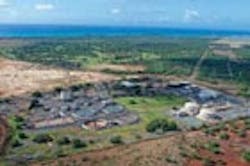Agreement Reached With City and County of Honolulu on Wastewater Systems
A comprehensive settlement has been reached with the city and county of Honolulu that will address Clean Water Act compliance at Honolulu’s wastewater collection and treatment systems, the Justice Department, U.S. Environmental Protection Agency (EPA), Hawaii Attorney General’s Office, Hawaii Department of Health and three environmental groups announced.
The settlement, which also resolves lawsuits brought by the Sierra Club, Hawaii’s Thousand Friends and Our Children’s Earth Foundation, includes a comprehensive compliance schedule for the city to upgrade its wastewater collection system by June 2020. Under the settlement, the Honouliuli wastewater treatment plant will need to be upgraded to secondary treatment by 2024. The Sand Island plant will need to be upgraded by 2035, but could be extended to 2038 based on a showing of economic hardship.
Work on the wastewater collection system will include rehabilitation and replacement of both gravity and force main sewer pipes, backup strategies to minimize the risks of force main spills, a cleaning and maintenance program, improvements to Honolulu’s program to control fats, oils and grease from entering into the wastewater system from food establishments and repair to pump stations.
"Today's settlement represents a significant commitment that will address the city and county of Honolulu's aging wastewater collection and treatment systems," said Ignacia S. Moreno, assistant attorney general for the Justice Department's Environment and Natural Resources Div. "The end result will not just be an improvement to the system's infrastructure. It will also significantly reduce both the public health risk caused by exposure to pathogens in raw sewage and the amount of harmful pollutants entering Honolulu's vibrant marine environment.
“This settlement will lead to significant improvements in water quality for the people of Oahu, and for the visitors to the island’s world-class beaches. It calls for aggressive actions in the near term to upgrade the city’s sewage collection system, and set outs a longer term schedule for construction of secondary treatment at the Sand Island and Honouliuli plants,” said Jared Blumenfeld, EPA’s Administrator for the Pacific Southwest region. “The work is on a multi-year schedule to allow the city to spread out the costs of this critical program.”
“This settlement has many positive features, and among the biggest are the collection system improvements to prevent future major raw sewage discharges, as happened at the Ala Wai Canal in 2006,” said Laurence Lau, the State Department of Health’s Deputy Director for Environmental Health.
In addition, the city will be paying a total fine of $1.6 million to be split between the federal government and the state of Hawaii to resolve violations of the federal Clean Water Act and the state of Hawaii’s water pollution law, such as the March 24, 2006, Beachwalk force main break that spilled approximately 50 million gal of sewage into the Ala Wai Canal.
Source: U.S. EPA
